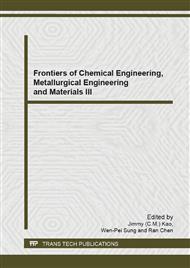p.3
p.9
p.16
p.20
p.25
p.33
p.38
p.43
Research on the Properties of Controlling Corrosion and Scale Inhibition of the Modified Starch with Microwave loading
Abstract:
To gain good environmental reagent with no or lower phosphor in controlling corrosion and scale inhibition. We have researched the following contents: On the base of the conventional oxidation method, microwave radiation was used to the three oxidation process: DAPS (namely dialdehyde potato starch) was made with potato-starch oxidated by NaIO4, then carboxylated to make Carboxyl Potato Starch (CPS), furthermore, phosphorylated to obtain Oxidation Phosphate Potato Starch (OPPS), and researched the properties of controlling corrosion and scale inhibition of OPPS with or without microwave loading. And draw the following results:Not only was the oxidation rate of OPPS increased by microwave loading, but also the whole oxidation time was shorten from Sixteen hours and thirty minutes to one and half an hour comparing with the conventional oxidation way without microwave loading. Furthermore, the crustation inhibitor rate of OPPS to incrustant formed by calcium carbonate reached over ninety percent when temperature changed from seventy to eighty degrees, and the controlling corrosion rate of OPPS to brass H62 and Carbon-steel Q235 reached over ninety percent when the concentration of OPPS was altered from 120 to 200 milligram per litre, which were all higher than that of the contrast team. Moreover, the phosphorus content of OPPS is poor than that of the other universal reagents such as HEDP (namely two hydroxy ethidene phosphonic acid) and ATMP (namely amino three methylene phosphonic acid).
Info:
Periodical:
Pages:
9-15
Citation:
Online since:
August 2014
Authors:
Price:
Сopyright:
© 2014 Trans Tech Publications Ltd. All Rights Reserved
Share:
Citation:


